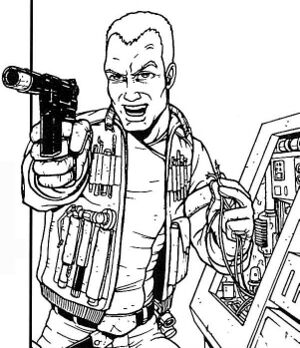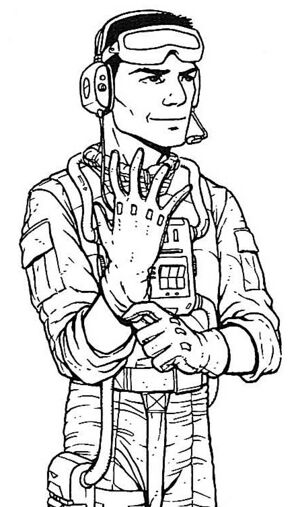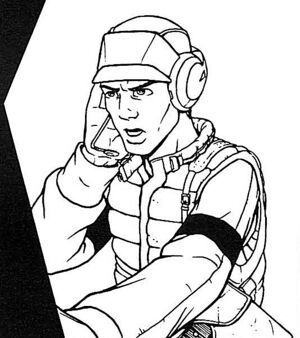Technicians/Legends
- "Never forget your weapon was made by the lowest bidder."
- ―Armorer to trooper
Technicians were a collection of varied military specialists assigned to the Alliance to Restore the Republic's Special Forces. They included mechanical technicians, combat engineers, medics, drivers, pilots, sensor and communications specialists, interrogators, and procurement specialists. Fully combat capable, they were assigned to combat Spec units to augment and support their operations.
Organization
Technicians were a military specialty within the Alliance to Restore the Republic's Special Forces.[1] The 7th Regiment of a SpecForce division was comprised of Technicians. Technicians were a catch-all regiment for all the various miscellaneous specialities attached to SpecForce. Although "Technicians" referred to the regiment as a whole, the formation included mechanics, technicians, medics, drivers, pilots, communications experts, scanner operators, interrogators, and procurement specialists.[2] As a whole, Technicians supported the other SpecForce regiments, operating and repairing equipment, and manufacturing whatever was needed. Technicians never operated as a single unit, and were always cross-attached to other formations[1] either individually or as a unit.[2] Each Technician was fully combat capable, and were expected to fight alongside other Specs on the battlefield if needed.[1]
History
Squads of Technicians were assigned to support other taskforces, including Taskforce Shen and Team 19.[2]
Personnel
Technicians were comprised of a variety of different Specs. Each Technician was already highly trained in their field of expertise, and it was far easier to train a technical expert to SpecForce combat standards than to train a SpecForce soldier to the same level of technical expertise. During training, Technicians were mixed with other units for the first half of their time at drop camp, then went on to specialist training. They were commonly referred to as "techs," or SpecTechs."[2]
Technicians/Engineers/Medics

- "Don't worry. I can fix this."
- ―A Technician
Specs drawn from technical or medic backgrounds were usually students at a university on their homeworlds, and were victims of political purges initiated during Galactic Empire crackdowns despite having no interest in politics. They joined the Alliance, and found that their skill set was needed and were assigned to the military. After a few tours, they found themselves transferred to SpecForce, where they became a capable combat soldier as well. SpecForce training took technical minded individuals without confidence, and turned them into experience technicians with a toughened edge and experience. Despite their new outlook and mindset, they were still techies at heart, and their main goal was to help their squad and compete the mission alive.[2]
Specialist training for technicians varied by specialization. For mechanical technicians, this included weeks of learning how to make quick and dirty repairs, and perform patchwork modifications. Medics were taught field medicine, and demolitions experts learned many amusing and interesting ways to employ detonite.[2]
Drivers/Pilots

- "There we go, troops: a nice smooth ride…hey, you all right? You guys are turning green."
- ―A Technician
Transportation Specs were divided into two camps; ground drivers, and space pilots. The vehicles they operated were heavily armed and armored, overpowered, and needed to be handled with care. Many transportation Specs were former circuit racers who believed they had extraordinary skills and the attitude to back it up. After being blacklisted because one of their associates had suspected Rebel ties, they joined the Alliance. Although probably skilled enough, piloting starfighters did not appeal to them, leading to their assignment to SpecForce. Drivers operated ground vehicles, transporting Specs to the front lines. They were capable of driving all forms of ground vehicle, from personnel carriers, to skiffs, to tanks. They were repeatedly called on to direct their vehicles into hot combat zones, a situation military drivers were usually trained to avoid. Pilots flew shuttles and transports to deliver Specs to a battlefield. While not as glamorous a job as piloting a starfighter, combat pilots had to deal with enemy starfighter action and static defenses while ensuring the safety of the units they were transporting. Many carried over traditions from their racing days, including racing gloves and lucky ornaments, and they harbored desires to return to the racing circuit once the war was over. Cocky and sure of themselves, years of combat missions had matured the transportation Specs, and they put the unit first.[2]
Following drop camp, drivers and pilots were taught emergency maintenance, and how to offensively use their vehicles, which was in direct contravention of standing Alliance doctrine regarding ground vehicle operation. Much of the training was in simulation pods, but live training was also conducted.[2]
Scanner-Communications Operators

- "I've got a signal! North by northwest…50 meters."
- ―Scanner-Communications Operator
Scanner-Communications Operators were responsible for using and maintaining the equipment that was the eyes, ears, and mouthpiece of SpecForce. Considered to be valuable squad members, they were usually assigned to most taskforces with few exceptions; Infiltrators almost never used them. All Operators were cross-trained in sensor and communications operations, and worked both if the taskforce was of a small size. Larger taskforces with more technical support usually had dedicated operators for each position. Scanner-Communications Operators were drawn from specialist within the Alliance whose combat scores qualified them for front-line combat duty. After a single tour, many opted to joined SpecForce since they were always looking for specialists, and they figured that if they were to be involved in combat operations, they might as well go all in. Scanner-Communications Operators tended to be on the nervous side, as they were often aware of the larger tactical picture than their squadmates, and they knew the position they occupied on the team was a critical one. Nevertheless, they were determined to complete the mission, and to serve the Alliance to the best of their ability. Amongst their fellow Specs, they were often referred to as "scanners," "scan-com operators," "sensor spec," or "eyes."[2]
Following basic drop camp, Sensor and communications operators learned additional operational techniques, field repair and maintenance, and cryptography. Their final test was designed to show them that they and their equipment were often the first line of defense by pitting them against a unit of Infiltrators.[2]
Interrogator
- "Listen, I'm only the first interview. If you don't cooperate…well, you've heard about Wookiees and arm."
- ―Interrogator
SpecForce interrogators differed greatly from their Imperial counterparts; the Empire used torture as a means for extracting information. However, the method was inefficient, as many would say whatever the interrogators wanted them to say to end the pain. SpecForce interrogators only required military information, not political confessions, and used a combination of subtle methods including intimidation, manipulation of perceptions—sleep deprivation, and telepathic probes. SpecForce interrogators were deployed to field, and were assigned when time was of the essence, or the subject could not be moved. While telepathic methods of information extraction were preferred due to time constraints, naturally occurring telepaths such as Horteks were in constant demand and short supply. This resulted in Interrogators adopting other methods, such as dominating the subject, engaging in false camaraderie, and mental manipulation. One of the favored methods was known as "acceleration," where the subject is manipulated into believing that more time has passed than has actually elapsed, and that time-critical information they held was now useless and out-of-date. Simulated torture was another method, where the prisoner was subjected to simulated sounds of torture in the next room with the implication that they would be next.[2]
Procurement Specialist
- "Combat supply is short of everything but the enemy."
- ―Common complaint from soldiers
Procurement specialists were tasked with the acquisition and retrieval of combat material from unorthodox sources while deployed in the field. Vital to the overall success of most missions, procurement specialists were assigned to taskforces slated to be in the field for medium or long term missions. They obtained needed equipment and supplies through any means possible, be that legal purchases, borrowing, theft, requisitions, or liberation from the enemy. They often had to locate and retrieve the items themselves without support, and they were often lacking in the combat arts than their fellow Specs. Buying supplies was generally the preferred method of acquisition, with procurement specialists reveling in making deals, but running cons or straight up commandeering of the equipment was also popular, In some cases, remove of equipment was arranged to look like a simple robbery. They were often referred to as "scroungers" by their fellow Specs.[2]
Skills
All SpecForce Technicians shared basic skills, with specialist skills in their areas of expertise. Useful specialist skills included demolitions, equipment repair, communications and sensor operation, emergency medical techniques, and creative engineering. While they were less combat capable than Specs from other regiments, they were fully trained soldiers and were used to augment other Spec units. All specializations were trained to handle a blaster. Technicians, combat engineers, and medics were trained in survival techniques and repulsorcraft operation, as well as basic stealth. Individual specialities varied, and Specs were often skilled in a number of techniques and disciplines including armor repair, blaster repair, computer programming and repair, droid programming and repair, hover vehicle repair, ground vehicle repair, repulsorlift vehicle repair, walker repair, demolitions, and first aid. Drivers and pilots were also skilled with vehicle mounted weapons and trained in first aid, and had special skills according to what vehicle they were trained in and assigned to drive, including hover, ground, and repulsorlift vehicles, and space transports. Scanner-Communications Operators specialized in operating communications and sensor equipment, including their maintenance and repair. First aid knowledge was also taught to them. Interrogators were conversant in other languages and trained in first aid, and used intimidation, personal willpower, and a commanding presence to their advantage. Procurement specialists were knowledgeable about bureaucracies, businesses, alien cultures, and languages. They were sneaky and stealthy, and were able bargainers, con-men with a persuasive personality. They had contacts with criminal undergrounds, and could bypass security systems.[2]
Equipment
Standard equipment for Technicians varied depending upon specialization, but all Technicians were appropriately equipped while in the field. Repair technicians were armed with a heavy blaster pistol, and carried a technical tool kit. Combat engineers were also armed with a heavy blaster pistol, and carried a cube of detonite and a datapad containing technical manuals. Medics carried five medpacs, an advanced medical kit, and no weapons. Drivers and pilots were issued with a blaster pistol, as well as their appropriate vehicle depending on the mission parameters. Scanner-Communications Operators carried a blaster pistol, and appropriate equipment such as comsets or scanners, as well as comlinks. Interrogators wielded a blaster pistol, as well as a datapad and a recording rod. A portable uniform fresher and wash-up kit were carried and employed to make the interrogator appear freshly-groomed during acceleration interrogations, and an interpretation droid was used on occasion. Procurement specialists carried a blaster pistol, datapad, and lock breaking kit.[2]
Sources
- The Rebel Alliance Sourcebook
- Heir to the Empire Sourcebook
- The Rebel Alliance Sourcebook, Second Edition
- Alliance Intelligence Reports
- The Thrawn Trilogy Sourcebook
- Rules of Engagement: The Rebel SpecForce Handbook